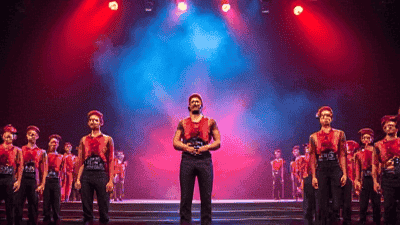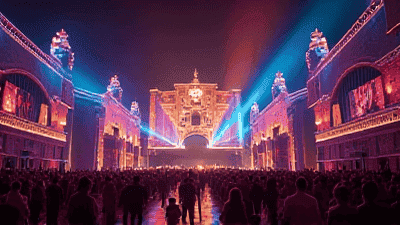
Exploring Global Travel Entertainment: From Spontaneous Street Art to Grand Stage Spectacles
Travel entertainment encompasses a vast spectrum of experiences, from the impromptu rhythms of street performers to the meticulously choreographed spectacles of grand theatres. Far from mere leisure, these performances are vital cultural ambassadors, reflecting the soul of a destination. They transform ordinary journeys into extraordinary memories, often hiding complex layers of history, tradition, and artistic ingenuity beneath their captivating surfaces, inviting a deeper look into their mechanisms and impact.
This diverse landscape of entertainment plays a crucial role in shaping global tourism, driving local economies, and fostering cross-cultural understanding. It provides a unique lens through which travelers can engage with a destination's heritage, contemporary arts, and social dynamics. From the ancient traditions of indigenous storytelling to the cutting-edge technology of modern theme park shows, travel entertainment stimulates dialogue, preserves artistic forms, and creates shared human experiences. The scientific community and tourism industry continuously analyze its economic impacts, psychological benefits, and the delicate balance between authenticity and commercial appeal. What impact would it have on our understanding or our practice of global tourism and cultural exchange if we failed to fully comprehend the profound significance and intricate evolution of travel entertainment?
The Raw Pulse of Street Performance

Unveiling the Spontaneity and Authenticity of Public Art
Street performance, often considered the most accessible and raw form of travel entertainment, thrives on spontaneity and direct audience engagement. These performances, ranging from buskers' melodies to impromptu dance-offs, are characterized by their organic emergence in public spaces, transforming squares, parks, and sidewalks into stages. The mechanism of street performance lies in its immediate interaction: artists adapt to crowd reactions, weather conditions, and ambient noise, creating a unique, unrepeatable experience. This dynamic interplay fosters a genuine connection, often breaking down traditional performer-audience barriers. In cities like New Orleans, street jazz musicians embody this spirit, their soulful improvisations echoing through the French Quarter, drawing crowds with their unadulterated passion. Research indicates that street art significantly contributes to a city's cultural vibrancy and perceived livability, acting as a crucial element in place-making and local identity. For instance, the mime artists in European city centers, with their silent narratives, communicate across language barriers, demonstrating the universal appeal of visual storytelling. This form of entertainment often operates on a "pay-what-you-feel" model, directly tying an artist's livelihood to their ability to captivate and move their audience, representing a pure exchange of art for appreciation.
Immersive Cultural Journeys
Engaging with Heritage Through Rituals, Storytelling, and Interactive Displays
Beyond passive observation, many forms of travel entertainment offer profound immersive cultural journeys, where audiences become active participants in narratives, rituals, and historical reenactments. These experiences delve deep into a culture's heart, using performance to convey ancestral stories, spiritual beliefs, and communal values. The principles behind these immersive encounters often involve carefully curated environments, skilled performers who act as cultural interpreters, and opportunities for audience interaction. For example, in Japan, a geisha performance is not merely a dance or song; it is an intricate art form (gei) deeply rooted in tradition, requiring years of training in various disciplines like music, dance, and conversation. Attendees engage in an intimate setting, learning about the subtle nuances of Japanese etiquette and artistic expression. Similarly, the Maori Haka in New Zealand, originally a war cry, is now performed as a powerful demonstration of cultural pride and welcome, often involving visitors in learning its significance and movements, thereby fostering a direct connection to indigenous heritage.
These performances are crucial for cultural preservation and education, offering insights that textbooks cannot. Their value lies in creating a living bridge to the past, making history palpable and traditions vibrant.
| Type of Entertainment | Cultural Focus | Audience Engagement | Authenticity Level |
|---|---|---|---|
| Geisha Performance | Traditional Arts, Etiquette | Observational, Interactive | High |
| Maori Haka | Indigenous Heritage, Spirituality | Participatory, Observational | High |
| Medieval Festivals | Historical Reenactment, Craft | Interactive, Experiential | Medium |
This table illustrates how different immersive experiences vary in their cultural focus and the level of audience participation, with high authenticity levels often maintained through adherence to traditional practices. The impact of such events is profound, as visitors often report a deeper empathy and understanding of local customs, leading to more respectful and informed travel behaviors.
Grand Theatrical Spectacles and Modern Innovations

The Evolution of Performance: From Broadway to Digital Frontiers
At the pinnacle of travel entertainment lie grand theatrical spectacles, characterized by their elaborate productions, professional casts, and often, significant technological integration. These performances, epitomized by Broadway and West End musicals or the global phenomenon of Cirque du Soleil, represent the zenith of artistic and technical craftsmanship. The principles governing these shows involve intricate scriptwriting, complex choreography, sophisticated lighting and sound design, and often, breathtaking scenic automation. Unlike their street counterparts, these productions are meticulously planned and rehearsed, delivering a consistent, high-quality experience across multiple performances. Cirque du Soleil, for instance, blends traditional circus arts with narrative, music, and surreal aesthetics, creating immersive worlds that transcend language barriers and appeal to a universal audience. Their shows are not just acts of acrobatics; they are theatrical masterpieces that push the boundaries of human performance and stagecraft. Research in tourism consistently shows that such flagship entertainment venues are significant motivators for travel, drawing millions of visitors annually and substantially boosting local economies. The enduring popularity of shows like "The Lion King" or "Wicked" showcases how compelling storytelling combined with spectacular production values creates unforgettable memories for travelers, solidifying a destination's reputation as a cultural hub.
Conclusion
From the unscripted energy of street shows to the polished grandeur of theatrical productions, travel entertainment stands as an indispensable facet of the global tourism experience. We have journeyed through the raw authenticity of public performances, witnessing how buskers and impromptu acts forge direct, unforgettable connections with their audiences, embodying the spirit of local culture. We then explored the profound depths of immersive cultural journeys, where ancient rituals and storytelling transform passive spectators into active participants, fostering genuine cross-cultural understanding. Finally, we examined the apex of artistic and technical prowess in grand theatrical spectacles, where elaborate sets, professional talent, and cutting-edge technology converge to deliver world-class performances that draw millions and define cultural landscapes. The overarching theme is clear: whether spontaneous or meticulously planned, these diverse forms of entertainment collectively enrich travel, preserve heritage, and stimulate economies, proving their enduring value far beyond mere amusement.
Looking ahead, the landscape of travel entertainment is poised for significant evolution, driven by technological iterations and a growing demand for sustainable and authentic experiences. We anticipate potential breakthroughs in augmented and virtual reality, allowing for hyper-personalized and historically accurate immersive experiences that can transport travelers to different eras or fictional worlds from anywhere. Challenges will include balancing technological advancement with the preservation of live, human-centric performances and ensuring ethical practices in cultural representation. Macro scientific policies focusing on sustainable tourism will likely shape the development of eco-friendly and community-benefiting entertainment options. The integration of interdisciplinary approaches, combining neuroscience, psychology, and urban planning, could lead to innovative designs for public spaces that naturally foster artistic expression. Continuous research is vital to understand evolving traveler preferences, optimize economic impact, and safeguard the artistic integrity and cultural significance of these invaluable global treasures, ensuring that the magic of travel entertainment continues to captivate future generations.
Frequently Asked Questions (FAQ)

Q: How do street performances maintain authenticity while accommodating commercial needs in popular tourist destinations? A: Maintaining authenticity in street performances, especially in popular tourist destinations, is a delicate balance. The core of street performance lies in its spontaneity and direct connection, often rooted in local traditions or personal artistic expression. However, as tourism increases, so does the commercial pressure. Authenticity can be preserved when artists genuinely engage with their craft and local culture, rather than solely performing for financial gain or adopting generic acts that appeal to the broadest possible tourist demographic. Many cities implement licensing systems or designated performance zones, which can either help preserve authenticity by supporting local artists and regulating quality, or inadvertently commercialize it if quotas prioritize revenue over artistic merit. True authenticity often thrives in the unscripted moments, where an artist might improvise based on the crowd's energy or showcase a unique local talent. When street performers receive appreciation directly from their audience, it fosters a direct exchange that respects the art form. Challenges arise when performances become overly repetitive, geared towards easy tips, or when they are direct copies of other acts, losing their unique cultural or individual flair. Encouraging and supporting artists who are deeply connected to their local heritage, and providing platforms for emerging talent, are crucial strategies to ensure that street performances remain vibrant, genuine reflections of a place rather than merely transactional tourist traps.
Q: What are the ethical considerations involved in cultural or animal-based travel entertainment? A: Ethical considerations in travel entertainment, particularly concerning cultural or animal-based performances, are paramount and increasingly scrutinized. For cultural performances, a primary concern is authenticity versus commercial exploitation. Is the performance a genuine representation of a culture's traditions, or has it been simplified, exaggerated, or even invented solely for tourist consumption, potentially misrepresenting or trivializing sacred practices? This can lead to cultural appropriation, where elements of a culture are used without understanding or respecting their original context. Ethical providers prioritize collaboration with local communities, ensuring fair compensation for artists, respecting traditional protocols, and allowing local voices to shape the narrative. For animal-based entertainment, the ethical dilemmas are often more stark. The central question revolves around animal welfare: are the animals subjected to cruel training methods, unnatural living conditions, or forced behaviors that cause stress or harm? Activities like elephant riding, dolphin shows, or circus acts often raise serious concerns about animal abuse, habitat destruction, and the impact on endangered species. Responsible tourism advocates for the "do no harm" principle, promoting observation of animals in their natural habitats (e.g., ethical wildlife tours) over captive performances. Tourists are encouraged to research and choose operators that adhere to strict animal welfare standards, certified by reputable organizations, thereby supporting practices that prioritize the well-being and conservation of animals over mere entertainment.








